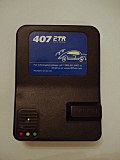Transponder

In telecommunications, a transponder is a device that, upon receiving a signal, emits a different signal in response.[1] The term is a blend of transmitter and responder.[2][3]
In
Satellite/broadcast communications
A
Optical communications
In fiber-optic communications, a transponder is the element that sends and receives the optical signal from a fiber. A transponder is typically characterized by its data rate and the maximum distance the signal can travel.
The term "transponder" can apply to different items with important functional differences, mentioned across academic and commercial literature:
- according to one description,full-duplexelectrical signal into a full-duplex optical signal. The difference between the two is that transceivers interface electrically with the host system using a serial interface, whereas transponders use a parallel interface to do so. In this view, transponders provide easier-to-handle lower-rate parallel signals, but are bulkier and consume more power than transceivers.
- according to another description,
As a result, differences in transponder functionality also might influence the functional description of related optical modules like
Aviation

Another type of transponder occurs in
Depending on the type of interrogation, the transponder sends back a
Transponders are used on some military aircraft to ensure ground personnel can verify the functionality of a missile’s
Marine
The
Automotive
Many modern automobiles have keys with transponders hidden inside the plastic head of the key. The user of the car may not even be aware that the transponder is there, because there are no buttons to press. When a key is inserted into the ignition lock cylinder and turned, the car's computer sends a signal to the transponder. Unless the transponder replies with a valid code, the computer will not allow the engine to be started. Transponder keys have no battery; they are energized by the signal itself. [10][11]
Road
Motorsport
Transponders are used in motorsport for lap timing purposes. A cable loop is dug into the race circuit near to the start/finish line. Each car has an active transponder with a unique ID code. When the racing car passes the start/finish line the lap time and the racing position is shown on the score board.
Passive and active RFID systems are used in off-road events such as Enduro and Hare and Hounds racing, the riders have a transponder on their person, normally on their arm. When they complete a lap they swipe or touch the receiver which is connected to a computer and log their lap time.
NASCAR uses transponders and cable loops placed at numerous points around the track to determine the lineup during a caution period. This system replaced a dangerous race back to the start-finish line.
Underwater
Sonar transponders operate under water and are used to measure distance and form the basis of underwater location marking, position tracking and navigation.
Gated communities
Transponders may also be used by residents to enter their gated communities. However, having more than one transponder causes problems. If a resident's car with simple transponder is parked in the vicinity, any vehicle can come up to the automated gate, triggering the gate interrogation signal, which may get an acceptable response from the resident's car. Such units properly installed might involve beamforming, unique transponders for each vehicle, or simply obliging vehicles to be stored away from the gate.
See also
- Acronyms and abbreviations in avionics
- Transponder car key
- Transceiver
- Muxponder
- Rebecca/Eureka transponding radar
References
- ^ "Definition of TRANSPONDER". 22 July 2023.
- ^ transponder
- ^ "Kunkune". Tech Accessories.
- ^ Optical Fiber Telecommunications V: Systems and networks, Academic Press, 2008, page 353-354
- ^ "WDM and DWDM Multiplexing Powerpoint presentation, School of Electronic and Communications Engineering, Dublin (Ireland), slide 61". Archived from the original on 2011-07-21. Retrieved 2011-02-16.
- ^ Fujitsu DWDM Primer, 2004
- ^ Dobkin, Daniel M. (2005). "A Radio-Oriented Introduction to Radio Frequency Identification". High Frequency Electronics.
- ^ Cook, Paul (2008). "TELEMETRY RE-RADIATION SYSTEM". Curtiss-Wright Desfense Solutions.
- SOLAS'1974. Archived from the originalon 2014-07-25.
- ^ "HOW DOES TRANSPONDER CAR KEY WORK?". 19 February 2015. Archived from the original on 2 May 2019. Retrieved 2 May 2019.
- ^ http://www.rfid-handbook.de/downloads/E2E_chapter03-rfid-handbook.pdf [bare URL PDF]
 This article incorporates public domain material from Federal Standard 1037C. General Services Administration. Archived from the original on 2022-01-22. (in support of MIL-STD-188).
This article incorporates public domain material from Federal Standard 1037C. General Services Administration. Archived from the original on 2022-01-22. (in support of MIL-STD-188). This article incorporates public domain material from Dictionary of Military and Associated Terms. United States Department of Defense.
This article incorporates public domain material from Dictionary of Military and Associated Terms. United States Department of Defense.
External links
- Transponding with DCC - Transponding in model railroading
